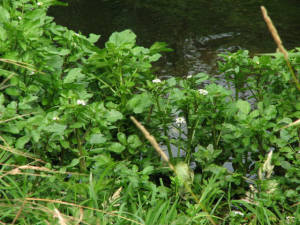Watercress is an aquatic plant that can be classed as either a plant or a vegetable. It is a highly nutritious plant packed full of vitamins. Recently it has become a bit of a ‘fad’ food for its supposed anti-cancer properties and other health benefits. In the wild it is most frequently seen in moving bodies of water.
‘Planting’ Watercress
It’s possible to harvest your own watercress for planting for a fast-moving stream. The faster the water the better, as it is more likely to be disease free. Alternatively cuttings can be bought from a store. Water plants must be able to root easily due to the challenging environment that moving water provides, and watercress is no exception – it only takes about a week to set up roots when grown in water.
If you are fortunate enough to have a stream on your property you can plant the roots of the watercress at the side of the stream in the moist soil. Most readers will not be so lucky, though, and will need to use alternative means of propagation. The keys to growing watercress are simply moisture and sunlight. Use a pot with drainage holes and a high quality compost and plant about an inch deep using a dibber. Space each watercress about 4 inches (10cm) apart. Before planting, make sure you soak the compost thoroughly. A general rule of gardening is to never soak soil, but be sure to break it here. It should be almost the consistency of mud.
Growing Watercress
If you planted near a stream, no attention is required. They will simply flourish over time.
If you planted in a pot, make sure to water very regularly. Twice a day is ideal. Keep it as moist as possible. A simple trick is to submerge the pot in a bowl of water that is changed regularly.
Remove the flowers to promote the best leaf growth.
Harvesting Watercress
Watercress can be harvested gradually. Do not over-harvest in the first season if you want your plants to continue to produce well. It stores poorly and is therefore best eaten fresh.
Threats to Watercress
If the stream you are growing in is full of pollutants, the watercress can be affected. Be sure that the stream is clear and healthy. Avoid growing by still water – only moving will suffice in order to prevent disease.
Bugs will occasionally get to watercress grown in pots or containers. The best method is to use a stream of water to blast them off.

